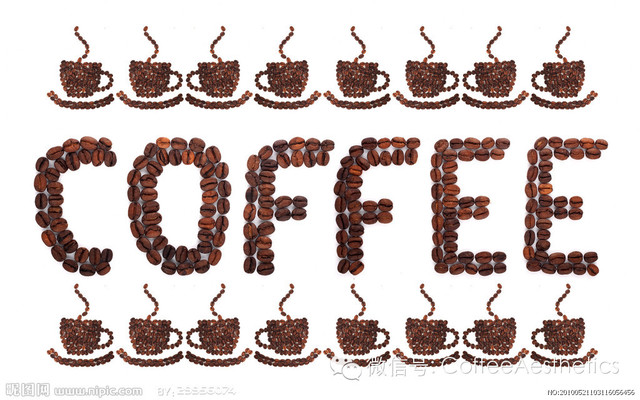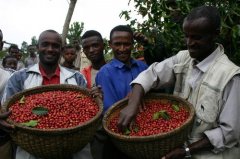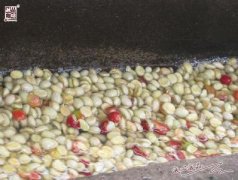Wet treatment to make coffee drink clean and rich
Boutique coffee beans must be excellent varieties, such as the original bourbon species, mocha species and Tippica species. The coffee beans produced by these trees have unique aroma and flavor, which is far from that of other tree species, but the relative yield is low. in recent years, in order to pursue the ability of disease and insect resistance and increase the yield, there have been many improved tree species, such as Kenya to promote a large number of high-yield rurial11 species, but the taste and quality are greatly reduced. Of course, you can't call it "boutique coffee".
Wet treatment method
The wet treatment process requires more capital investment and more energy, but this method helps to ensure the quality of coffee beans and reduce damage. The main difference between the wet and dry methods is that during the wet treatment, the pulp is immediately separated from the coffee beans instead of drying them.
The pulp is separated in a separator-in a machine with a fixed surface and a movable surface, or in a machine with a movable rod, the fruit is crushed so that the pulp is separated from the coffee bean. In order to ensure the quality of coffee beans, the pulp must be separated as soon as possible after harvest, which is ideal within 12 hours, but not more than 24 hours. Because, if the coffee beans are kept for too long, the pulp will become difficult to separate from the coffee beans, resulting in incomplete separation and possible damage to the coffee beans. Therefore, the coffee beans treated by wet treatment have good luster, less foreign bodies and better sour taste, but bad time treatment will produce stinky smell and special sour smell.
The peel and pulp separated from the coffee beans will be washed off with water. The flushing tank is designed to separate light and tender coffee beans from thick and ripe coffee beans. This kind of separation can also be done by the "Austrian high score machine". Ogao, a coffee grower in Norway, designed a device to filter coffee beans into a large water container while growing coffee in Kenya. The large, full beans were the first to sink into the water, while the lighter beans stayed in the large container. In this process, water can be recycled.
The next step is the most basic fermentation, that is, the use of enzymes to separate the greasy glue that covers the inner pericarp. Coffee beans are stored in a fermentor for about 12 miles for 36 hours, which is mainly determined by the ambient temperature, the thickness of the glue and the enzyme. When this process is completed, the endocarp around the coffee beans is no longer slippery but has a pebble-like feel.
In the whole wet treatment process, quality control is very important to prevent coffee tofu from rotting, because even one rotten coffee bean may damage all coffee beans. For this reason, the equipment used must be cleaned every day to ensure that no impurities are left before the next round of processing.

Important Notice :
前街咖啡 FrontStreet Coffee has moved to new addredd:
FrontStreet Coffee Address: 315,Donghua East Road,GuangZhou
Tel:020 38364473
- Prev

Coffee beans are processed by drying.
Fine coffee beans must be good quality beans without blemishes. It should have outstanding flavor, not without bad taste, but taste particularly good, coffee bean processing coffee beans refined processing about rough processing, separation, classification, fermentation, drying, shelling, polishing, classification, etc. 8 procedures. There are two ways to prepare coffee beans for the roasting process. The method chosen for coffee
- Next

What is the shelling of coffee beans?
Before exporting, brown beans should be treated by grinding, which is to remove the endocarp from the coffee beans to be sold. The residual shell of coffee beans after removal and cleaning of endocarp and drying process is also known as peeling or peeling. It is more difficult to remove the endocarp of coffee beans during wet treatment than during drying, so different shelling machines are needed. There are two main models:
Related
- Guji coffee producing area of Guji, Ethiopia: Humbela, Shakiso, Wulaga
- What is the most expensive variety of Qiloso in BOP multi-variety group?
- How to store the coffee beans bought home?
- Why are Yemeni coffee beans so rare now?
- Ethiopian Sidamo all Red Fruit Sun Sun Santa Vini Coffee beans
- SOE is mostly sour? What does it mean? Is it a single bean? what's the difference between it and Italian blending?
- Is Italian coffee beans suitable for making hand-brewed coffee?
- How to choose coffee beans when making cold coffee? What kind of coffee beans are suitable for making cold coffee?
- Just entered the pit to make coffee, what kind of coffee beans should be chosen?
- Can only Japan buy real Blue Mountain Coffee? What are authentic Jamaican Blue Mountain coffee beans?

